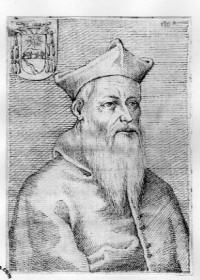Tiberio Crispo (31 January 1498 – 10 October 1566), the son of Giovanni Battista Crispo and Silvia Ruffini, who, after her husband's death, was the mistress of Alessandro Farnese. It was believed that Tiberio was an illegitimate son of Farnese, who became Pope Paul III. He was certainly a natural brother of Costanza Farnese (born ca. 1500)[1] and Ranuccio Farnese (died 1529), the two undisputed legitimate children of Paul III, who were born before his election as pope in 1534.[2][3][4]

Biography
editTiberio Crispo began his career as a Canon and Prebendary of the Vatican Basilica.[5] On 11 April 1543 Pope Paul III granted him the right of making his own will.[6] He was also cubicularius secretus.
From June 1542 to April 1545 Crispo was the castellan of Castel Sant'Angelo.[7]
He was appointed Bishop of Sessa Aurunca in Campania, in the province of Caserta in the Kingdom of Naples, on 6 July 1543, though he resigned the post in the next year in favor Bartolommeo Albano,[8] who was appointed on 7 June 1544.[9]
Tiberio Crispo was raised to the cardinalate on 19 December 1544 by Paul III. He was assigned the deaconry of S. Agata de' Goti from 1545 to 1551. On 20 November 1551 he was promoted to the Order of Cardinal Priests, but he was allowed to continue to hold the deaconry of S. Agata as though it were a titulus, pro illa vice (on that one occasion) until 1562.[10] On 18 May 1562 he was promoted Cardinal Priest of S. Maria in Trastevere.[11]
He was appointed Administrator of the Diocese of Sessa Aurunca (1565 – 27 June 1566) during the vacancy caused by the death of Bishop Galeazzo Florimonte.[12]
As papal legate to Perugia, Crispo was a "driving force behind the architectural renewal of the city".[13] For example, in 1547 Crispo commissioned Galeazzo Alessi for the construction of Santa Maria del Popolo to replace a church demolished by the construction of the Via Nuova.[14][15] He also commissioned a palace in Bolsena that bears his name, Palazzo di Tiberio Crispo (also known as the Palazzo Crispo Marsciano or Palazzo Rondanini alla Rotonda), which was designed by Antonio da Sangallo the Younger circa 1543;[16] after the death of Sangallo in 1546, Raffaello da Montelupo was called in to finish the palace, which remained incomplete, however, after the deaths of both Crispo and Raffaello in 1566.[17]
Historical research indicates that Crispo also likely owned the "Palazzo Nobile" in Rome, a palace originally commissioned for Thomas Cardinal Wolsey circa 1507 before passing to the Aldobrandini family; Crispo likely commissioned the 400 square metres of frescos in the palace which celebrate the life of Paul III.[3]
After the death of Paul III, Crispo participated in the conclaves of 1549-1550[18] (administrator of Amalfi at the time), April 1555 (administrator of Sessa Arunca and Amalfi at the time),[19] May 1555,[20] 1559,[21] 1565-1566[22] (bishop of Sabina at the time).[23]
Research related to the life and patronage of Crispo is ongoing in historical archives in Rome (States Archives, Vatican Secret Archives, Vatican Library) and Umbria (States Archives of Foligno, Historical Diocesan Archives of Perugia, States Archives of Perugia).[24]
References
edit- ^ Roberto Zapperi, "Costanza Farnese," Dizionario Biografico degli Italiani 45 (1995)
- ^ Miranda, Salvador. "CRISPI, Tiberio (1498-1566)". The Cardinals of the Holy Roman Church. Florida International University. OCLC 53276621.
- ^ a b Guido Di Capua. ""The Conservative Restoration Project for the Property on the First Floor of the 'Palazzo Nobile' at 48 Piazza Rondanini in Rome" Archived 2007-04-11 at the Wayback Machine.
- ^ Abd-el-Kader Salza, "Pasquiniana," Giornale storico della letteratura italiana (ed. Novati and Renier) 43 (Torino: Ermanno Loescher 1904), p. 200
- ^ Francesco Maria Torrigio, Le sacre grotte Vaticane terza impressione (Roma 1675), p. 612
- ^ Cajetanus Cennius et Antonius Martinetti, Collectionis Bullarum brevium aliorumque diplomatum Sacrosanctae Basilicae Vaticanae Tomus Secundus (Roma 1750), pp. 435-436.
- ^ George Anthony Bull. 1999. Michelangelo: Life, Letters, and Poetry: Life, Letters, and Poetry. Oxford University Press. p. 169. P. Pagliucci, I Castellani del Castel S. Angelo I (Roma 1906), pp. 108-114.
- ^ It is reported that Bartolommeo Albano was Tiberio Crispo's nephew: Tommaso de Masi, Memorie istoriche degli Aurunci antichissimi popoli dell'Italia (Napoli 1761), p. 138. If this is correct, then one should note that Tiberio Crispo had a sister. Cf. F. Ughelli and N. Colet, Italia sacra VI (Venice 1720), p. 545: Bartholomeus Albanus, Urbevetanus, Crispi Cardinals ex sorore nepos.
- ^ G. Gulik and C. Eubel, Hierarchia catholica editio altera (curavit J. Schmitz-Kellenberg) (Monsterii 1923), p. 305. Lorenzo Cardella, Memorie de' Cardinali della Chiesa Romana Santa IV, 272, exaggerates in giving Tiberio Crispo three years in office.
- ^ Miranda, Salvador. 1998. "Deaconries".
- ^ Gulik and Eubel, p. 66.
- ^ Gulik and Eubel, p. 305. He was not Bishop a second time.
- ^ Jane Turner. 2000. Encyclopedia of Italian Renaissance & Mannerist Art, 2 volumes. Grove's Dictionaries. ISBN 0333760948. p. 30.
- ^ Adolf K. Placzek. 1982. Macmillan Encyclopedia of Architects. Collier Macmillan. ISBN 0029250005. p. 63.
- ^ "Santa Maria del Popolo (ca. 1547) Archived 2009-01-05 at the Wayback Machine".
- ^ Michele D'Innella. Umbria. ISBN 8836528376. p. 184.
- ^ The palace was bought incomplete by Ludovico Marsciano in 1582: "Orvieto - Walk I Archived 2008-10-05 at the Wayback Machine".
- ^ Sede Vacante and Conclave of 10 November 1549--8 February 1550 (Dr. J. P. Adams).
- ^ Sede Vacante and Conclave of 23 March--9 April, 1555 (Dr. J. P. Adams).
- ^ Sede Vacante and Conclave of 1-23 May, 1555 (Dr. J. P. Adams).
- ^ Sede Vacante and Conclave of 18 August-- 25 December, 1559 (Dr. J. P. Adams).
- ^ Sede Vacante and Conclave of 9 December, 1565--7 January, 1566 (Dr. J. P. Adams).
- ^ Miranda, Salvador. 1998. "Conclaves of the 16th Century (1503–1592)".
- ^ Antonio Pinelli. "Art and politics: public and private celebrations. Case studies, tipologies and comparisons.." Ricerca Italiana.